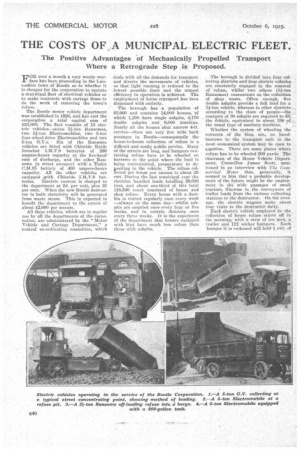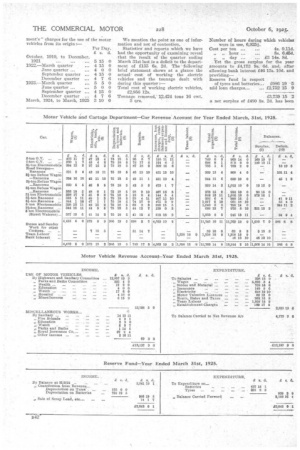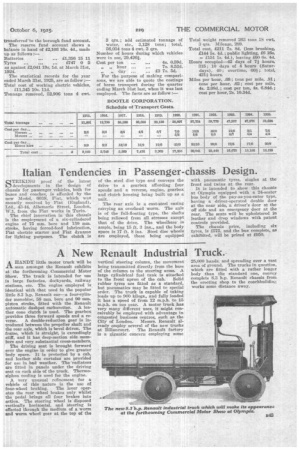THE COSTS OF,A MUNICIPAL ELECTRIC FLEET.
Page 24

Page 25

Page 26

Page 27

If you've noticed an error in this article please click here to report it so we can fix it.
The Positive Advantages of Mechanically Propelled Transport Where a Retrograde Step is Proposed.
MICR over a month a very wordy war12 fare has been proceeding in the Lancashire town of Bootle as to whether it is cheaper for the corporation to operate a municipal fleet of electrical vehicles or to make contracts with cartage firms to do the work of removing the town's refuse. .
The Bootle motor vehicle department was established in 1920, and has cost the corporation a total capital sum of £23,000. The fleet consists of 13 electric vehicles—seveu 3k-ton Ransomes, two 3k-ton Eleetromobiles, two 5-ton four-wheel-drive Electromobiles and two 5-ton G.V.s. Six of the Ransom° vehicles are fitted with Chloride Exide Ironclad I.M.V.9 batteries of 290 ampere-hours capacity at the five-hout rate of discharge, and the other Ransome (a street sweeper) with` a Tudor C.M.15 battery of 460 ampere-hours capacity. AU the other vehicles are equipped 4ivith Chloride I.M.V.9 bat
teries. Electric current is charged to the department at 2d, per unit, plus 25 per cent. When the new Bootle destructor is built electricity will be generated from waste steam. This is expected to benefit the department to the extent of about £2,000 per annum.
All these vehicles, which are in regular use by all the departments of the corporation, are administered by the "Motor Vehicle and Cartage Department," a central co-ordinating committee, which deals with all the demands for transport and directs the movements of vehicles, so that light running is reduced to the lowest possible limit and the utmost efficiency in operation is achieved. The employment of horse transport has been dispensed with entirely.
The borough has a population of 83,000 and contains 14,000 houses, of which 1,290 have single ashpits, 4,170 double ashpits and (1,000 dustbins. Nearly all the houses 'abut narrow 4-ft. entries—there are very few wide back passages in Bootle—consequently the house-to-house collection of refuse is a difficult and costly public service. Many of the streets are long, and hampers containing refuse have to be wheeled on barrows to the point where -the load is being concentrated, preparatory to dejesiting in the vehicle. The refuse colrected per house per annum is about 25 cwt. During the last municipal year the electric, handled loads totalling 59,630 tons, and about one-third of this total (18,500 tuns) consisted of house and shop refuse. Every house with a dustbin is visited regularly once every week —always on the same day—whilst ashpits are emptied once every four or five weeks, and in certain districts once every three weeks. It is the experience of the department that houses equipped with bins have much less refuse than those with ashpits.
The borough is divided into four collecting districts and four electric vehicles are constantly engaged in the removal of refuse, whilst two others (n-ton Ransomes) concentrate on the collection of shop waste. Often enough, five double ashpits provide a full load for a 3h-ton vehicle, whereas in other districts according to the class of people—the contents of 30 ashpits are required to fill the s'ehicIe, equivalent to about 150 of the usual type of sanitary dnstbins.
Whether the system of wheeling the contents of the bins, etc., on handbarrows to the transport unit is the most economical system may he open to question. There are some places where refuse has to be wheeled 200 yards. The oh-airman of the Motor Vehicle Department, Councillor James Scott, mentioned in an interview with The Commercial Motor that, personally, it seemed to bins that a probable development of the future might be the employment in the wide passages of small tractors, likewise in the conveyance of trailer loads from the various collecting stations to the destructor. On the average, the electric wagons make about four visits to the destructor daily.
Each electric vehicle employed in the collection of house refuse starts off in the morning, with a crew of ten men, a trailer and 112 wicker hampers. Each hamper it is reckoned will hold cwt. of refuse. On reaching the first collecting station, the trailer and four men are dropped, and the work of loading up the trailer is started immediately. At station No. 2 three inen and 56 hampers are deposited, and the same at No. 3. Here the motor remains until the contents of the 56 hampers have been tipped into the motor, which then proceeds ,to station No. 2, where a similar load is picked up, and then to No. 1 for the trailer load. Thus the work proceeds, the loaded trailer being left at the destructor yard and an empty one brought back to the scene of operations. In the actual clearance of the contents of the baskets into the motors, one heaver is employed to two wheelers.
One of the Raneonie 3i-ton dust carriers was, some time ago, converted by the department into a street sprayer and sweeper. On the body a 500-gallon tank was placed and a horizontal sprayer fitted to the front of the vehicle. One full of water is sufficient to spray five miles of streets. This vehicle,on the average, covers 25 to 26 miles per day. The useful life of one of the revolving brushes is 100 miles. The brushes now in use were originally made for a horse-sweeper and are made from West African piassava ; probably it would be found that a mixture of West African and Bahia would give better results, even if more costly.
Another interesting unit is the 5-ton Eleetromobile, which has also been converted by the department into a streetwaterer. This now carries a 900-gallon tank. On occasions it has traversed as much as 29 miles of streets in one day, but a fairer average is 22 miles per day (43 loads) for the summer months. One Ilene vehicle would spray about 22 loads, covering about six miles in one day.
Certain vehicles, for instance a 5-ton Electromobile and a 5-ton G.V„ are built with steel end-tipping bodies, which are particularly useful for loads of clinkers, granite chippings, gravel, setts, etc. When working_ les the _service of the Highways Deparftent, between the docks, stations, depots and road and other works, these units frequently make seven journeys a day, equivalent to a load tonnage of 35. On short hauls, as much as 47 tons has been cleared by one vehicle in one-day. When employed on such work these vehicles are staffed by two or three loaders, whose combined remuneration is 9d. per ton, divisible
equally. It has been found that this method of payment has promoted the expeditious clearance of loads and has accelerated the working of the vehicles.
Since the "Motor Vehicles Department" was started, five years ago, according to Coun. J. Scott, chairman of the Highways, Sanitary and Cartage Committee, the department has refunded no less an amount than £6,246 to the relief of rates. The department made a gross profit of over £4,000 during the last municipal year, and of this sum £987 was transferred to the reserve fund, £2,753 was utilized in the repayment of loans with interest, and the balance of £480 was transferred to the borough fund. The outstanding liability on the department on March 31st last was £8,930. Against this the department has in the reserve fund (cash
in hand) £4,669. The difference of these two sums is just over £4,000. He hopes that at the end of two years the
department will be free of debt, or, rather, in such a position as to have sufficient money in hand to pay off the debt.
Any department of the corporation may hire transport units from the " Motor Vehicle Department," the charge being one of £3 10s. per day. This, incidentally, is one of the points of criticism directed against the department. It Is alleged by one councillor that by " overcharging " the various departments of the corporation the "Motor Vehicle Department" has created surpluses which otherwise would not have existed, and he mentioned that the current rates, as fixed by the Liverpool Short Cartowners Association, are £3 10s. per day for 4 to 6-ton motor tipping vehicles with two men, and £3 per day for vehicles below four tons. As the corporation fleet consists of four 5-ton and nine 3i-ton vehicles, he points out that the average current rate for the fleet would be £3 3s. per day per vehicle, or, to take a more liberal rate, for the sake of argument, say £3 5s. per day. He gives the following as the Bootle "Motor Vehicle Depart ment's " charges for the use of the motor vehicles from its origin We mention the point as one of information and not of contention.
Statisticsand reports which we have had the opportunity of examining reveal that the result of the quarter ending March 31st last is a deficit to the department of £135 6s. 24. The following brief statement shows at a glance the actual' cost of working the electric vehicles and the tonnage dealt with during this quarter :
Total cost of working electric vehicles, £2,959 12s.
Tonnage removed, 12,424 tons 16 cwt. 3 arc. Number of hours during which vehicles were in use, 6,925i.
Cost per ton ... 4s. 9.11d.
>9 /I hour ••• ••• 8s. 6.45d.
day ... ... £3 14s. 84.
Yet the gross surplus for the year amounts to £4,173 9s. 64. and, after allowing bank interest £46 13s. 104. and providing
Reserve fund in respect of tyres and batteries... £986 19 5 afid loan charges... ... £2.752 15 9 transferred to the borough fund account. The reserve fund account shows a balance in hand of £2,103 16s. 4d., made up as follows : Batteries £1,356 15 11
Tyres ... £747 0 5
as against £2,041 19s. Id. at March 31st, 1924.
The statistical records for the year ended March 31st, 1925, are as follow :Total cost of working electric vehicles, £11,345 10s. 11d.
Tonnage removed, 52,906 tons 4 cwt. 3 qrs.; add estimated tonnage of water, etc., 3,128 tons ; total, 56,034 tons 4 cwt. 3 qrs.
Number of hours during which vehicles were in use, 29,4261.
Cost per ton 4s. 0.59d.
For the purpose of making comparisons, we are able to quote the costings of horse transport during the quarter ending March 31st last, when it was last employed, The facts are as follow : Total weight removed 263 tons 18 cwt. 3 qrs. Mileage, 289.
Total cost, £211 7s. 8d. (less brushing, £144 5s. 4d.; public lighting, £6 16s. = £151 1s. 4d.), leaving £60 Os. 4d.
Hours occupied-42 days of 74 hours, 315; 10 days of 4 hours (Saturdays), 40; overtime, 664; total, 4214 hours.
Miles per hour, .68; tons per mile, .91; tons per hour, .62; cost per mile, 4s. 2.08d.; cost per ton, 45. 6.84d.; cost per hour, 2s. 10.34d.
































